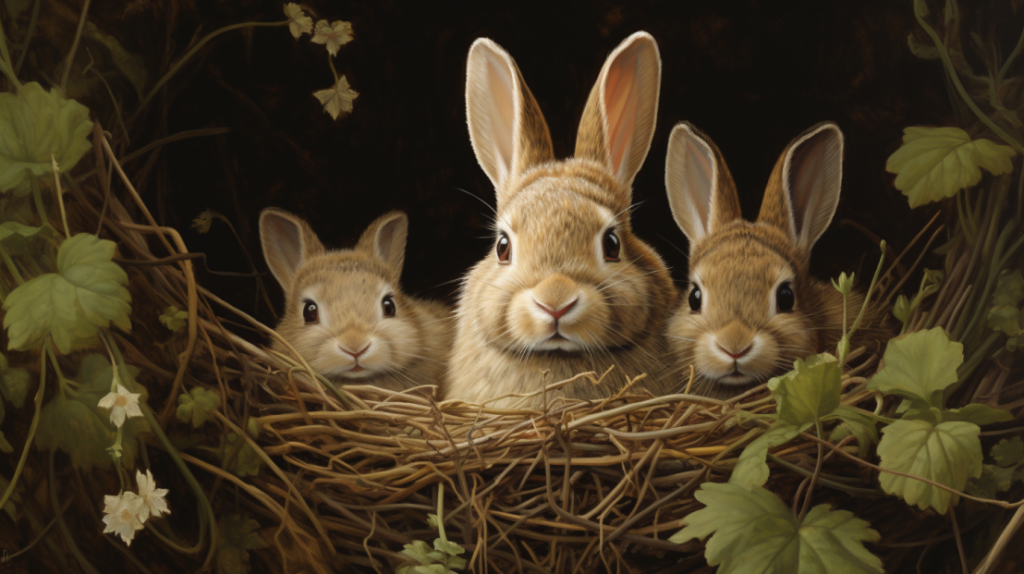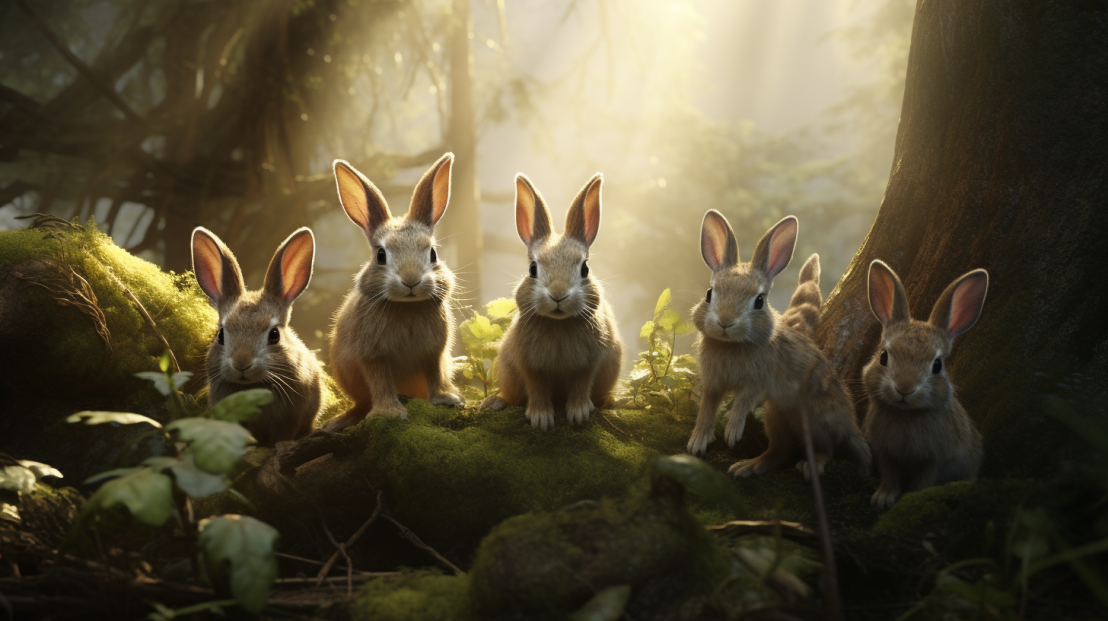If you’ve ever wondered what a group of rabbits is called, you’ve come to the right place! The collective noun used to describe a gathering of rabbits depends on the context in which they are found. Domesticated rabbits kept as pets are often referred to as a “fluffle of rabbits.” This term perfectly captures the image of these adorable creatures hopping and playing together in a fluffy bundle of cuteness. On the other hand, a group of wild rabbits living in their natural habitats is commonly known as a “colony of rabbits.” Let’s delve deeper into the fascinating social structure and behavior of these furry creatures.
The Social Structure of Rabbits
Within a group of rabbits, a hierarchical social structure emerges. This structure is adapted to their survival needs and ensures the overall harmony of the colony. Understanding the social dynamics of rabbits provides valuable insights into their behavior and interactions. Here’s a closer look at the different roles within a group of rabbits:
Dominant Rabbits (Alpha Rabbits)
At the top of the rabbit hierarchy are dominant individuals, often referred to as alpha rabbits. These rabbits have a higher status within the group and hold control over essential resources such as food and mating opportunities. Dominant rabbits are typically larger and more assertive than their subordinates. They use their dominance to maintain order and ensure the well-being of the colony.
Submissive Rabbits
Beneath the dominant rabbits are the subordinate individuals. These rabbits occupy a lower rank in the social structure and display deferential behavior towards their dominant counterparts. Submissive rabbits have limited access to resources and often yield to the dominant rabbits during conflicts or when it comes to sharing important resources. They play a crucial role in the overall dynamics of the group and contribute to its stability.
Territorial Nature
Rabbits are known for their territorial behavior, especially when living in groups. They mark their territories using scent glands and dig burrows known as warrens. These warrens serve as communal living spaces and provide protection against predators. Within the warren, rabbits create a complex network of tunnels, burrows, and chambers. This interconnecting system of living spaces helps ensure the safety and well-being of the entire colony.
Communication among Rabbits
Communication plays a fundamental role in the social interactions of rabbits. These adorable creatures employ various methods to express their intentions and establish social bonds. Here are some ways in which rabbits communicate within their group:
- Vocalizations: Rabbits use different vocalizations to convey their emotions and intentions. They make soft purring sounds when content, growl or hiss when threatened, and emit high-pitched screams when in pain or distress.
- Body Language: Rabbits communicate a lot through their body language. They may thump their hind legs on the ground as an alarm signal, flatten their ears when frightened, and raise their tails in a defensive posture. Additionally, rabbits can showcase dominance or submission through postures such as standing tall or crouching low.
- Scent Marking: Rabbits have scent glands on their chin, cheeks, and anal area. They use these glands to mark their territories and establish ownership. Through scent marking, rabbits communicate information about their presence, status, and reproductive readiness to other members of their group.
Grooming and Bonding
Grooming is an essential behavior among rabbits that not only helps them maintain cleanliness but also forms strong social bonds within the group. Grooming involves rabbits using their mouths and tongues to clean each other’s fur. Here’s why grooming is so significant for rabbits:
- Establishing Trust: Grooming helps establish trust and strengthen social connections among rabbits. It is a way for them to show affection and care for one another.
- Maintaining Social Hierarchy: Grooming reinforces the social hierarchy within the group. Dominant rabbits often receive more grooming sessions from their subordinate counterparts, further solidifying their position.
- Stress Relief: Engaging in grooming behavior can help alleviate stress and promote relaxation among rabbits. It provides a sense of comfort and security within the group.
Reproductive Behaviors of Rabbits
Rabbits have a unique reproductive system that contributes to their social dynamics. Understanding their reproductive behaviors provides valuable insights into the intricate nature of their social structures. Let’s explore some key aspects of rabbit reproduction:
Mating Patterns
Rabbits are known for their rapid breeding capabilities. They have a short gestation period that lasts around 30 days. Female rabbits, known as does, are receptive to mating for a short period after giving birth. This phenomenon, known as postpartum estrus, allows rabbits to have multiple litters within a year. As a result, the population of a rabbit colony can increase rapidly.
Dominant Males
Within a group of rabbits, dominant males, also known as bucks, have exclusive mating rights. They establish their dominance through displays of aggression and assertiveness. Dominant males compete for the attention of receptive females and engage in aggressive behaviors, such as boxing and mounting other males, to establish their dominance.
Reproductive Success
The dominance hierarchy within a rabbit group ensures the reproductive success of the dominant individuals. The alpha males and females have better access to resources, including mates, which increases their chances of reproducing successfully. This hierarchy helps maintain the genetic diversity of the colony and ensures the survival of the fittest offspring.

Care of the Young
Rabbits are known for their attentive care of their offspring. After a short gestation period, the female gives birth to a litter of baby rabbits, called kits. The doe provides warmth and nutrition to the kits through nursing. The kits remain in the nesting burrow and rely on their mother’s care for survival. As they grow older, the kits gradually explore their surroundings, learning important skills for independence.
Interesting Facts about Rabbits
Now that we’ve explored the social structure and reproductive behaviors of rabbits, let’s uncover some fascinating facts about these adorable creatures:
- Did you know? The incisors of rabbits never stop growing! To prevent their teeth from becoming too long, rabbits chew on various items, such as hay and grass, which helps wear down their constantly growing teeth.
- Did you know? Rabbits have a field of vision of nearly 360 degrees, allowing them to see predators approaching from all angles. This wide range of vision helps rabbits effectively detect potential threats and stay safe.
- Did you know? Rabbits are crepuscular animals, which means they are most active during the dawn and dusk hours. This activity pattern allows them to avoid the intense heat of the day and the potential dangers of the night.
- Did you know? Rabbits have a highly developed sense of hearing. Their large, upright ears can rotate independently, enabling them to locate the source of sounds with great accuracy.
Frequently Asked Questions (FAQs)
Q: Do rabbits live in groups?
A: Yes, rabbits are social animals that typically live in groups known as colonies or warrens.
Q: What is the social structure of a rabbit group?
A: A rabbit group has a hierarchical social structure, with dominant rabbits (alpha rabbits) at the top and submissive rabbits below them.
Q: What are some common collective nouns for a group of rabbits?
A: A group of domesticated rabbits is often called a “fluffle,” while a group of wild rabbits is referred to as a “colony.”
Q: Can rabbits communicate with each other?
A: Yes, rabbits communicate using a variety of methods, including vocalizations, body language, and scent marking.
Conclusion
Rabbits are intriguing creatures with a rich social structure and fascinating behaviors. In this blog post, we explored the collective nouns used to describe a group of rabbits, delved into their hierarchical social structure, and uncovered their reproductive behaviors. We also uncovered interesting facts about rabbits that highlight their unique characteristics.
Next time you encounter a group of rabbits hopping around, you’ll have a better understanding of their social dynamics and appreciate the wonders of their behavior. So hop along and continue exploring the captivating world of rabbits!
Hey there, fellow nature enthusiasts! I’m Mark Gray, the passionate owner of OutdoorAnimals.com, a hub dedicated to uncovering the incredible world of outdoor animals. Whether you’re a hiker, a four-wheeler, or just someone who revels in the beauty of the great outdoors, you’re in the right place. I seek to understand all varieties of animals, from the great elk to the simple mouse, my goal is to write and share this knowledge with the public.

